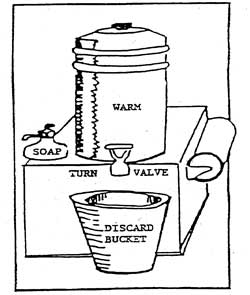Sampling produce:
- Wash Produce used for samples must be washed with cool water. If it is thick-skinned produce, scrub with a clean vegetable brush. This removes nearly all insects, dirt, bacteria and some pesticide residues that can contaminate the interior of the produce once it is cut.
- Store If washed produce is not cut for samples, immediately store it in a clean container to prevent re-soiling of the exterior surface prior to cutting.
- Protect Cut samples must be covered or protected if flies are present, the area is dusty, or weather conditions are such that the samples could become contaminated.
- Minimize Contact Minimize bare hand contact with cut produce. This can be done by using single service items (as described below). If single service gloves are used, change the gloves often to prevent soiled gloves from cross-contaminating samples. Remember to wash hands between changing gloves.
- Single Service Use single service items to distribute samples to customers. Examples are paper plates, cups, napkins, plastic utensils or toothpicks. The customer can then dispose of single service items once the product is consumed.
More Tips for Staying Trouble Free
- Storing food safely, easily. Store all food in food-grade containers or packing materials. Garbage bags are not food-grade – they’re treated with mold-inhibiting chemicals. And don’t reuse old bread sacks or grocery bags: These may have been contaminated by the food already stored in them.
- Ensure that transportation vehicles are clean & sanitary. Dirty vehicles can contaminate produce with harmful microbes.
- Keep garbage containers covered, and empty them often. It is recommended that each vendor supplying samples provide a small garbage can for used sampling containers or utensils.
- Prevent creature contact – don’t let rodents, insects, birds, etc., get at your food. Netted table tents keep flies and bugs off; they’re lightweight and come off easily when you need to serve or sell your product.
- Keep raw and prepared foods separate.
- Ice should be made from potable water only. Ice that has kept food cold should not be served for human consumption. Whenever possible, use cold packs to keep food cold – they’re more economical, and your food won’t get soggy. You can make your own cold packs from watertight containers.
- Store chemicals, including cleaning solutions, away from food.
Warm water (100 °F – 120 °F) can be held in a 5-gallon insulated container with a spigot that allows continuous flow. A bucket can be used to collect dirty water. Liquid soap and paper towels should be provided and a trash receptacle for discarded paper towels.

Carolyn Benepe, M.S. student, and Pat Kendall, PhD, RD, Department of Food Science and Human Nutrition, Colorado State University Extension.
